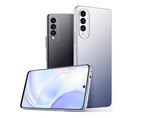Huawei Nova 8 SE Youth
Specifications

Secondary Camera: 16 MPix f/2.0
Price comparison
Reviews for the Huawei Nova 8 SE Youth
Source: OI Spice Tech News
 Archive.org version
Archive.org versionThe Huawei Nova 8 SE Youth smartphone is a fairly obvious entry-level phone that offers an impressive design. Also, the charging speed and customization are noteworthy, while the camera quality seems a little disappointing. Apart from that, you will not get 5g support but if you are looking for a phone with an aesthetic look, you can check out the nova 8 SE Youth phone. But if the performance and camera are your priority you should check something else. However, if you are looking for an alternative to the Nova 8 SE Youth, the best choice would be the Realme Q3 Pro smartphone for its full value for money.
Single Review, online available, Medium, Date: 08/14/2021
Comment
Series:
Huawei's phone business may be embattled due to software problems but it has not stopped making new phones. While most of them have not made it to European shores, the latest Huawei Nova 9 is an exception to this. In terms of its design, this device is still considered thin at 7.8mm and light at 175g. This definitely makes it rather portable while the curved edges keep it comfortable to be held on too. The rear camera module on the back comes in two different circles which houses the main camera and the remaining lenses. However, this model has no Gorilla Glass on the display and there is also no water or dust-resistant IP rating. As far as the display is concerned, the Huawei Nova 9 has been incorporated with a large 6.75-inch Full HD+ OLED display with high colour coverage. This is paired with an impressive 120Hz high refresh rate. In addition, there is also an under-display fingerprint reader, which can be quite fast and reliable. In terms of its performance, this is a firmly mid-range device which uses the Qualcomm’s Snapdragon 778G chipset paired with an 8GB of RAM with either 128GB or 256GB of storage. It is undeniable that this is not the fastest or most powerful phone on the market, but it has got more than enough power for the average user. The performance is rather smooth and fluid even when multi-tasking, and there is enough power to run any modern smartphone game too.
In terms of its battery, the Huawei Nova 9 comes in with a 4300mAh battery which is enough for the phone to last a day’s use fairly comfortably, but definitely not enough to stretch it to two days unless for an exceptionally light usage. Fundamentally that makes the battery life fairly average for the modern market as there are phones with better battery life out there, but this is obviously not the worst though. As for its camera, this smartphone carries a 50MP main camera, 8MP ultrawide camera, 2MP macro camera and a 2MP depth sensor. The main camera being encased in its own circular housing, utilizes Huawei's RYYB pixel arrangement which the company prefers especially for low light performance. However, in this device it is not combined with optical image stabilization (OIS) which is key to really excellent night photography. Overall, in daylight the main camera is exceptional with rich colours and vivid detail in a range of conditions. Though in darker lighting results are good, the lack of OIS does show. Apart from that, the ultrawide does the job in decent lighting, but there is a marked drop in detail compared to the main lens while colours tend to be washed out. There is also a 32MP selfie camera which is quite decent. Overall, it is a great phone to be considered if the absence of Google Mobile services is not an issue.
ARM Mali-G51 MP4: Integrated mid range graphics card with 4 clusters. Beware the results in the Mate 20 Lite, that detects benchmarks and boosts the performance.
Only some 3D games with very low demands are playable with these cards.
» Further information can be found in our Comparison of Mobile Graphics Cards and the corresponding Benchmark List.
Kirin 710A: ARM based octa-core SoC containing four Cortex-A73 cores for performance tasks (up to 2.2 GHz) and four Cortex-A53 cores (up to 1.7 GHz) to save power. Furthermore, the SoC integrates an LTE radio (600 MBps down) and a ARM Mali-G51MP4 GPU. The SoC is manufactured at TSMC in 12nm.» Further information can be found in our Comparison of Mobile Processsors.



